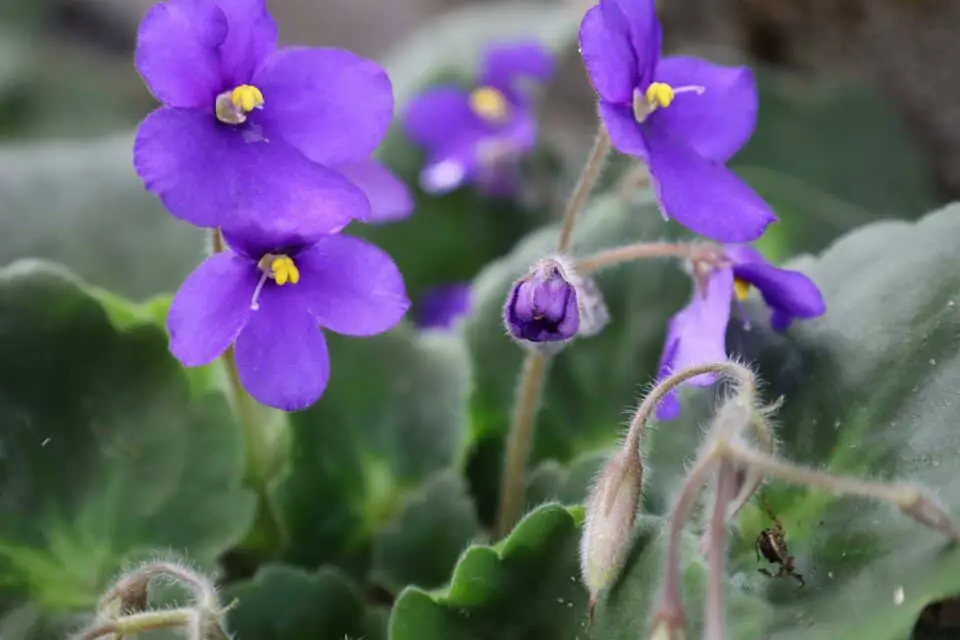Some links in the post are affiliate links and I get a commission from purchases made through some links found in the post.
How much humidity does the African violet tolerate? Is there a limit to how high or low the humidity levels should be in your home?
The answer to this lies in the nativity of the African violet, a plant that comes from Africa. It grows in a mountainous region, surrounded by other tropical plants.
And as you may have already guessed, the African violet has a moderate to high humidity need. You are better off aiming for anything between 70% and 80%, as this is what the plant gets in its native environment.
I will get into how you can tell that your plant needs more humidity and how you can meet this need. Also, does your plant like misting? It’s time you found out:
What Is the Ideal Humidity for An African Violet?
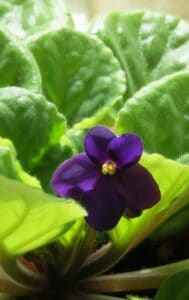 Let’s start with why humidity is important to plants. Plants depend on transpiration and evaporation to move nutrients through their systems, make food, and thus thrive.
Let’s start with why humidity is important to plants. Plants depend on transpiration and evaporation to move nutrients through their systems, make food, and thus thrive.
When the evaporation rates are high, the plants must pull more water through their root systems. So, the more the African violet loses water, the more it uses up what is in the soil.
Now, how does this relate to humidity? When the humidity is low (i.e., water vapor is available at low concentrations), the plant starts losing more water to the environment through evaporation.
And it may be unable to take up enough water to replace what is lost – and that wreaks havoc on the plant’s system as it can no longer keep up with its sustenance at an optimal level.
The problem is more severe with the African violet because it grows in a tropical region. Thus, it has not developed the features necessary to slow down evaporation and transpiration rates when the need arises.
It is, therefore, at risk of some of the issues that accompany low humidity, as I will detail in a later section.
Can humidity kill your African violet? Not at all – this is not an issue that can lead to the demise of the plant.
However, by interfering with the transpiration processes, low humidity can slow your plant’s growth and affect its flowering.
We all know that this plant flowers throughout the year in ideal conditions – and one of these key requirements is high humidity.
How can you ensure your African violet does not fall victim to humidity issues? You can keep the range between 70% and 80%.
The African violet can still do well between 50% and 70%, but these would not have the same aesthetic effect as higher rates. Any lower than 50% is a recipe for trouble, as you will later see.
How To Find Out the Humidity in Your Home
I’ve thrown out some figures above. 50%, 70%, 80% – but how can you tell the exact humidity in your home? You will need a hygrometer for this.
While there are other methods (like the wet bulb dry bulb test), using this device is the easiest and most accurate way to arrive at a percentage.
What affects the humidity in your home? Tons of things, including your heating and cooling systems. Also:
- The weather,
- Your climate,
- Whether you have other plants in the home,
- The ventilation in the space, etc.
That’s why your humidity levels in the summer may be ideal at around 70%, and yet in the fall, they drop to around 60%.
You need to keep checking the humidity levels each season and whenever you move the plant to another spot.
They will always fluctuate. But not to worry, though. You can tell when they are off, and you can fix them almost immediately.
How To Increase the Humidity In Your Home
So, the humidity in your home has fallen to less than 50%. What can you do to get it to the ideal range? Here are a couple of ideas:
- You can group the African violet with other plants: Here is an easy way to create an ecosystem in your home. As the other plants transpire, they will release water vapor into the air, benefiting the African violet.
- You can add mulch to the base of the plant: This works by enabling the soil to retain more water to keep up with the evaporation rates. Thus, the flow of water vapor into the air takes on a more regular rate.
- You can place some water bowls around the plant: The water will evaporate into the air and create a humid environment which will allow your African violet to do much better. You can work with shallow bowls as they have a wider surface area, increasing the evaporation rate.
- You can install a humidifier around the plant: It constantly releases water vapor into the air and does not require you to keep checking on it.
- You can grow the African violet in a terrarium where you have control over its growing conditions: Containing it like this bars the water vapor from escaping into the environment and allows the plant to bathe in its water vapor.
Alternatively, you can move the plant to more humid spaces in your home, like the kitchen and bathroom. The options are quite numerous, and you can find one that aligns with your home.
You may also like: African violet vs violet
What Are the Signs the Humidity Is Not Ideal for Your African Violet?
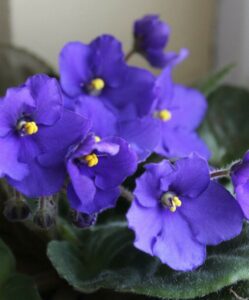 Does the African violet have tell-tales that all is not well? It does. An African violet left in low humidity will show signs of:
Does the African violet have tell-tales that all is not well? It does. An African violet left in low humidity will show signs of:
- Browning on the leaf edges,
- A reduced rate of growth,
- Poor flowering,
- Darkening on the sides of the leaves, and
- Crisping of the leaves.
These changes result from the lack of adequate transpiration. However, some of these signs can arise when the plant has too much water, has suffered overwatering, has been sunburnt, or has too much fertilizer.
So, it would help if you considered these causes before altering the humidity in your space.
Do African Violets Need a Humidifier?
Need is a strong word. What your plant needs is a high humidity range. And you don’t need to use a humidifier for this.
You can use any methods I mentioned above, and your plant would be fine. However, using a humidifier is ideal if you or other people in the home feel that the air is too dry.
That way, you can kill two birds with one stone. Plus, humidifiers can release both warm and cold drafts, enabling you to change the humidity even in the winter. Getting one would not be a bad move – but it is not necessary.
Do African Violets Like to Stay Moist?
There are two levels of being moist. The first refers to the soil where you plant the African violet, and the second refers to the leaves. I will start with the first.
African violets enjoy being in slightly moist soil as this allows them to transpire effectively. The plant can replace the water lost through its leaves by absorbing what is in the soil, enabling it to remain healthy.
Ideally, the plant should be in slightly moist soil and never sit in soggy soil. Why? When you leave the African violet in soggy soil, the roots end up deprived of oxygen.
And this damages them and creates an ideal environment for fungi to grow and attack the roots even further.
Such a plant will show signs of yellowing and dropping of leaves. And if you do not stop overwatering the plant, it can suffer root rot that spreads to the stems and kills it.
Overwatering can arise from:
- Watering the African violet when the top two inches of soil are not dry,
- Limiting the air circulation around the plant,
- Using the wrong type of potting mix (using a peat-based mix works best), and
- Potting the plant in a container with few drainage holes (clay pots are the most ideal).
So, as far as the roots go, the African violet does not appreciate being moist and leans better on the slightly moist part of the scale.
How about the leaves? Read the next section to find out if the African violet leaves should be wet and how you can go about this.
You may also like: Can African violets grow outside?
Do African Violets Like to Be Misted?
Did you know that African violets prefer being watered from the bottom? You can either direct the water to the base of the plant or soak the soil using a bath.
That’s how much they prefer having their leaves stay dry. So, should you mist the leaves to increase the humidity around the plant? There are two sides to this coin.
The Advantages of Misting
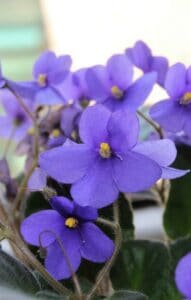 Misting often works for other plants. But is this the case with the African violet? There are a few advantages to misting. These are:
Misting often works for other plants. But is this the case with the African violet? There are a few advantages to misting. These are:
- Cleaning the leaves: Did you know that leaves accumulate dirt over time? This accumulation blocks them from receiving enough light and affects other plant processes. So, a good misting can help you get rid of this barrier.
- Added humidity: The water used in misting the plant evaporates and adds to the water vapor around the plant, thus enabling it to thrive.
Plus, misting is easy. But before you try it, please read about its cons below:
The Disadvantages of Misting
Are there reasons not to mist your African violet? Sure. These include:
- Fungal diseases: When the leaves of the African violet remain wet for too long, they become ideal environments in which fungi can thrive. And much like the case with root rot for the roots, diseases such as leaf spot and anthracnose can start exhibiting.
- The nature of the African violet leaves: While most other leaves would allow the excess water to cascade down the leaves, that is not the case with this plant. Its leaves trap water, and the longer this water remains on the leaves, the easier it is for fungi to grow. The issue is even worse if the room is hot.
- Mineral accumulation: This con depends on the type of water you use for misting. Rainwater should be fine. But tap water often contains many minerals, including chlorine and fluorine, which block the stomata and make it hard for them to take up moisture.
Misting also encourages pests to take up home in the African violet. Most pests thrive in humid regions, and providing them with water only increases the suitability of the plant as a home.
How To Mist Your African Violet
Seeing as misting can spell trouble for your plant, it is best to only do it occasionally and ensure that you use a little water at a time.
Also, if the humidity around the plant is enough, please do not mist the plant. Else, the water will sit on the leaves instead of evaporating, which would only cause a range of issues.
I would not recommend misting unless it’s the only way to raise the humidity for your African violet. If you must mist it, please proceed as follows:
- Fill a spray bottle with a little water. It’s even better to use neem oil, a natural pest repellent that will bar pests from making a home in your plant.
- Then mist the plant starting from the top to the bottom, using one pump per leaf. If the water is too much, please wipe it off with a cloth to keep it from sitting on the leaves.
- Ensure the plant is in a bright sunny spot where the water can evaporate from the leaves to keep it from sitting on the plant.
Also, space the misting, and preferably, only mist the plant once every other week.
Can You Keep African Violets in The Bathroom?
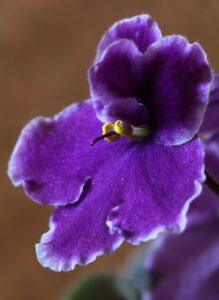 What if the other rooms in your home have low humidity, and you do not want to invest in the humidity-raising techniques discussed earlier?
What if the other rooms in your home have low humidity, and you do not want to invest in the humidity-raising techniques discussed earlier?
You don’t need to get a humidifier or group your African violet with other plants. Instead, you can locate it in the bathroom, where the humidity is moderate to high.
Ensure that you open the windows, though, to allow free air circulation. Poor ventilation plus humidity is a recipe for fungal growth.
If your bathroom does not have sufficient ventilation, you can move the plant to the kitchen, where the humidity levels are also acceptable. See? You might not need that humidifier after all.
Final Thoughts
Keeping an African violet happy is not difficult. Keep its humidity high, water it regularly, place it in bright light, and feed it when needed.
And just like that, you can enjoy healthy blooms all year long. Who would have thought it was so simple?
Happy Gardening!

